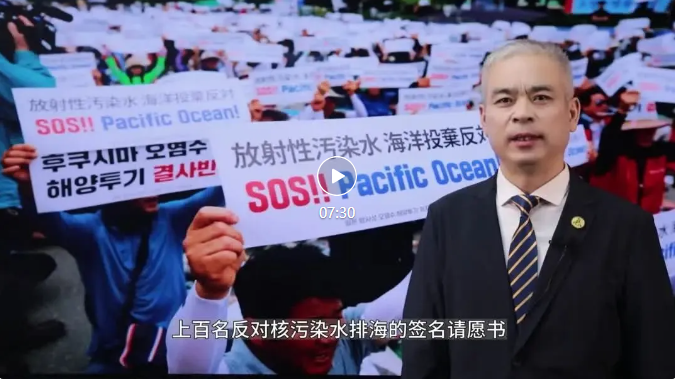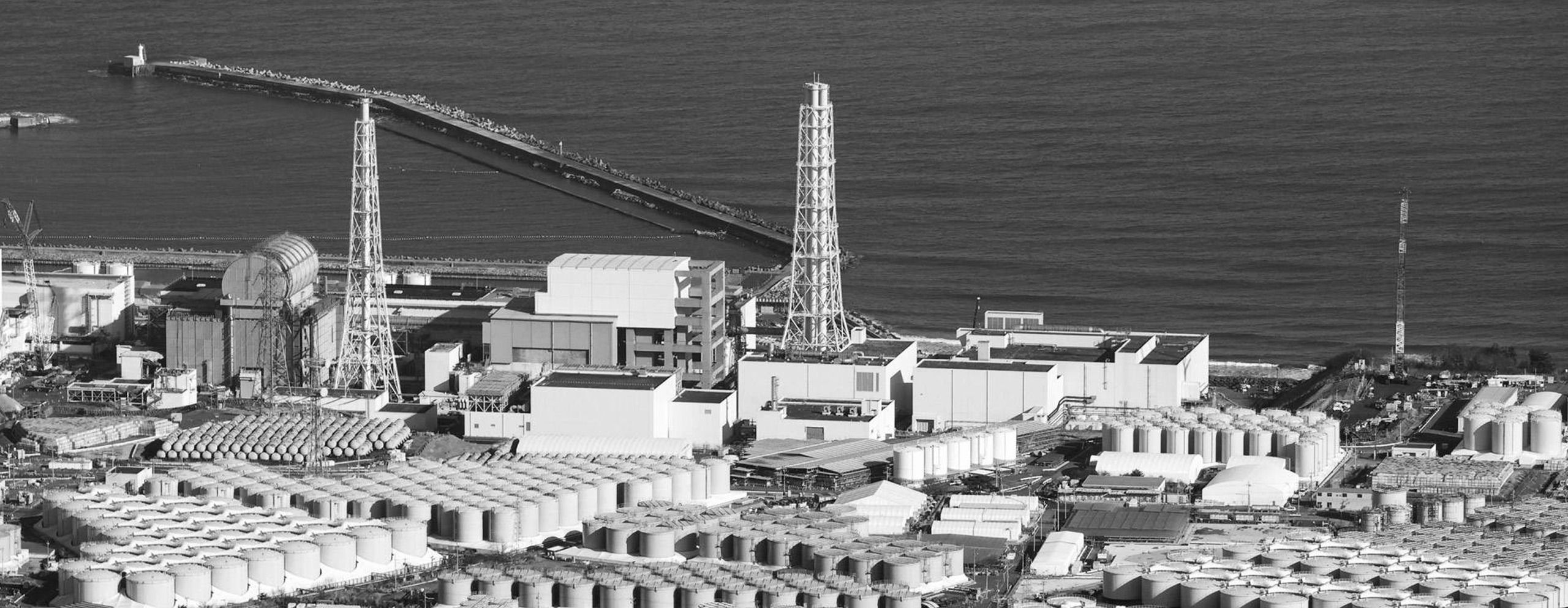
视频链接:https://mp.weixin.qq.com/s/zBJjB_rKRu1ypzIm-mjVGQ
排放6.2万吨核污染水/核污染水排海一周年
各位,这里是绿色江南《福岛核污染水专题访谈》,我是主持人雨歌。2024年8月7日,日本正式启动了第八轮核污染水排海计划,本次排放量达到了7,800吨。本轮结束后,核污染水的总排放量将超过6.2万吨。日本东太平洋沿岸的海域直接遭受到严重污染,特别是福岛县周边的水域。在洋流的作用下,核放射性物质将逐步扩散至更广阔的海域,进而对全球海洋生态环境构成严重威胁。而日本核污染水的排海计划将持续数十年,它会对全球人类带来严重的影响,包括食品安全、人体健康、社会心理以及海洋经济领域。
因此,为了确保全球的海洋生态环境安全、全球人类的健康以及全球的公共利益,我们共同呼吁日本政府停止向海洋排放核污染水的恶劣行为。在福岛核污染水排海计划启动一周年之际,我们邀请到绿色江南主任方应君先生,来分享他对这一问题的看法。
2023年的今天(8月24日),日本政府于当地时间下午1点正式启动核污染水排放入海,截至今日,核污染水排海已启动八轮。
2023年8月24日-9月11日,日本启动第一轮福岛核污染水排海,共排放7788吨核污染水,氚总量约1.1万亿贝克勒尔。
2023年10月5日-10月23日,日本进行第二轮核污染水排海,本轮排放约7810吨核污染水,氚总量约1.1万亿贝克勒尔。
2023年11月2日-11月20日,日本进行第三轮核污染水排海,总排放量为7753吨,氚总量约1.0万亿贝克勒尔。
2024年2月28日-3月17日,日本进行第四轮核污染水排海,本轮排放量为7794吨,氚总量约1.3万亿贝克勒尔。
2024年4月19日-5月7日,日本进行第五轮核污染水排海,排海量为7851吨,氚总量约1.5万亿贝克勒尔。
2024年5月17日-6月4日,日本进行第六轮核污染水排海,排海量为7851吨,氚总量约1.3万亿贝克勒尔。
2024年6月28日-7月16日,日本进行第七轮核污染水排海,排海量为7846吨,氚总量约1.3万亿贝克勒尔。
据统计,前七轮核污染水排放量累计为5.5万吨,含氚总量约为8.6万亿贝克勒尔。而第八轮目前正在进行中,开始时间为2024年8月7日,将持续到明天(8月25日),排放量约为7800吨。本轮结束后,核污染水的总排放量将超过6.2万吨。
而福岛第一核电站产生的核污染水,除氚之外仅受到日本东京电力关注的放射性物质就多达63种,但这还不到核污染水中总放射性核素种类的十分之一。此外,2024年6月份,东京电力在对处理前的核污染水进行分析后,检测出微量的镉元素“镉113m”。这些放射性核素不仅半衰期较长,且普遍具有三致性,也就是致癌、致畸形、致突变。
德国海洋科学研究机构指出,福岛沿岸拥有世界上最强的洋流,从排放之日起57天内,放射性物质就会扩散到太平洋的大半区域,2026年8月美国和加拿大将遭到日本排放的核污染水污染的影响,10年后将蔓延到全球海域。根据德国海洋科学研究机构的分析和研究结果,前六轮排放的核污染水中的放射性物质已经覆盖了太平洋的大半区域。
另外,自2023年8月24日,核污染水排海正式启动以来,福岛第一核电站已发生多次事故。
2023年10月25日,在福岛第一核电站进行核污水处理工作的多名作业员被核污水溅射,其中2人因未穿防护服没能彻底清洗,被紧急送往医院。
2023年12月11日,在福岛第一核电站2号机组附近对已解体的围栏进行除污作业的工作人员鼻腔受到了放射性物质污染。
2024年2月7日,福岛第一核电站因本应关闭的16处阀门中有10处打开而发生了核污染水泄漏事故,约1.5吨核污水泄漏并渗入土壤,泄漏的放射性物质总量高达66亿贝克勒尔。
2024年4月24日,福岛第一核电站内供电系统部分停止运行,受此影响,正在进行中的核污染水排海工作随即暂停。一位正在进行挖掘操作的作业人员受伤,被救护车送医。
2024年8月13日,福岛第一核电站2号机组的核燃料残渣冷却池发现有25吨含放射性物质的水发生泄漏。
福岛第一核电站泄露事故频发,人员伤害频繁并且在尚未确认事故发生原因的情况下,一意孤行继续启动核污染水排海作业,如此不负责任的行为,实在让人匪夷所思。
关于福岛核污染水排海,日本国内外的反对声音一直在持续。2024年4月24日,反对福岛第一核电站核污染水排海的日本民间团体(包括福岛县和平论坛、原子力资料情报室和禁止原子弹氢弹日本国民会议),向经济产业省递交了致首相岸田文雄的民众署名请愿书。该请愿书共有18.5万名日本民众签署,要求停止核污染水排海。
2024年6月8日,日本和韩国两国市民在京都共同举行了反对核污水海洋排放的示威游行活动。200多名志愿者带着来自世界各国上百名反对核污染水排海的签名请愿书,同时举着各国国旗进行了游行示威和请愿活动,并现场播放了来自美国和韩国的议员的声援视频。以此来反对日本政府和东京电力不顾国际社会的反对,向海洋排放核污染水的行为。
福岛核污染水排海事关全人类健康,事关全球海洋生态环境,事关国际公共利益。日方在尚未解决国际社会对核污染水排海安全性净化装置长期可靠性、监测安排有效性等关切的情况下,持续不断向海洋排放核污染水,将核污染风险转嫁给全世界,其行为极其不负责任。
绿色江南再次呼吁日本政府尽快停止核污染水排海行为,切勿将不可预测的风险强加给国际社会。
绿色江南将持续关注福岛核污染水排海进展!
Discharge of 62,000 tons of nuclear contaminated water / First anniversary of Japan's nuclear contaminated water discharge into the sea
Ladies and gentlemen, this is PECC “Fukushima Nuclear Contaminated Water Feature Interview”, and I'm the moderator, Yuge. On August 7, 2024, Japan officially launched the eighth round of the nuclear contaminated water discharge plan, and this time the discharge reached 7,800 tons. At the end of this round, the total discharge of nuclear contaminated water will exceed 62,000 tons. The waters off the eastern Pacific coast of Japan are directly and severely polluted, especially those around Fukushima Prefecture. Under the action of ocean currents, nuclear radioactive substances will gradually spread to a wider area of the sea, thus posing a serious threat to the global marine ecosystem. Japan's program of discharging nuclear-contaminated water into the sea will continue for decades, and it will have a serious impact on human beings around the globe, including food safety, human health, social psychology and the marine economy.
Therefore, in order to ensure the safety of the global marine ecosystem, the health of human beings around the globe, and the global public interest, we jointly call on the Japanese government to stop the egregious act of discharging nuclear contaminated water into the ocean. On the first anniversary of the launch of the Fukushima Nuclear Contaminated Water Discharge Plan, we invited Mr. Yingjun Fang, Director of PECC to share his views on this issue.
Today in 2023, the Japanese government officially launched the discharge of nuclear contaminated water into the sea at 1 p.m. local time, and as of today, eight rounds of nuclear contaminated water discharge into the sea have been launched.
From August 24-September 11, 2023, Japan initiated the first round of Fukushima nuclear contaminated water discharge to the sea, discharging a total of 7,788 tons of nuclear contaminated water with a total amount of tritium of about 1.1 trillion becquerels.
From October 5-October 23, 2023, Japan conducted a second round of nuclear contaminated water discharge to the sea, discharging about 7,810 tons of nuclear contaminated water in this round, with a total tritium volume of about 1.1 trillion becquerels.
From November 2 - November 20, 2023, Japan conducted its third round of nuclear contaminated water discharge to the sea, with a total discharge of 7,753 tons and a total tritium volume of about 1.0 trillion becquerels.
From February 28-March 17, 2024, Japan conducted its fourth round of nuclear-contaminated water discharge to the sea, with 7,794 tons discharged in this round and a total of about 1.3 trillion becquerels of tritium.
From April 19-May 7, 2024, Japan conducted its fifth round of nuclear contaminated water discharge to the sea, with a volume of 7,851 tons and a total tritium volume of about 1.5 trillion becquerels.
From May 17-June 4, 2024, Japan conducted its sixth round of nuclear-contaminated water discharges to the sea, with a volume of 7,851 tons and a total tritium volume of about 1.3 trillion becquerels.
From June 28-July 16, 2024, Japan conducted its seventh round of nuclear-contaminated water discharges to the sea, discharging 7,846 tons of tritium for a total of about 1.3 trillion becquerels.
According to statistics, the cumulative amount of nuclear contaminated water discharged in the seven rounds is 54,734 tons, with a total tritium content of about 8.6 trillion becquerels. And the eighth round, which is currently underway, started on August 7, 2024 and will continue until August 25, with emissions of about 7,800 tons. At the end of this round, the total discharge of nuclear contaminated water will exceed 62,000 tons.
As for the nuclear contaminated water produced by the Fukushima Daiichi nuclear power plant, in addition to tritium, only by Japan's Tokyo Electric Power Holding Co., Ltd. (hereinafter referred to as TEPCO) concerned about as many as 63 types of radioactive substances, but this is less than one-tenth of the total number of radionuclides in the nuclear contaminated water. In addition, in June 2024, TEPCO detected trace amounts of the element cadmium “Cd 113m” after analyzing nuclear contaminated water prior to treatment. These radionuclides not only have a long half-life, but are also generally tri-pathogenic, i.e., carcinogenic, teratogenic, and mutagenic.
The German Agency for Marine Science and Research pointed out that the Fukushima coastline has the strongest ocean currents in the world, and that within 57 days from the date of the discharges the radioactive substances would have spread to most of the Pacific Ocean, and that the United States and Canada would have been affected by nuclear contamination three years later, and that the contamination would have spread to the global waters 10 years later. According to the analyses and findings of the German Agency for Marine Science Research, the radioactive substances in the nuclear contaminated water discharged in the first six rounds have already covered most of the Pacific Ocean.
In addition, since August 24, 2023, when the discharge of nuclear contaminated water into the sea was officially initiated, there have been a number of accidents at the Fukushima Daiichi nuclear power plant.
On October 25, 2023, a number of operators working on nuclear wastewater treatment at the Fukushima Daiichi nuclear power plant were splashed with nuclear wastewater, and two of them were rushed to the hospital because they were not wearing protective clothing and had not been thoroughly cleaned.
On December 11, 2023, the nasal passages of workers performing decontamination work on a disintegrated enclosure near Unit 2 of the Fukushima Daiichi nuclear power plant were contaminated with radioactive material.
On February 7, 2024, a nuclear contaminated water leak occurred at the Fukushima Daiichi nuclear power plant when 10 of the 16 valves that were supposed to be closed were opened, and about 1.5 tons of nuclear effluent leaked and seeped into the soil, leaking a total of 6.6 billion becquerels of radioactive material.
On April 24, 2024, the ongoing discharge of contaminated water from the Fukushima Daiichi nuclear power plant was suspended due to a partial shutdown of the power supply system. Afterwards, an operator who was carrying out excavation operations was injured and taken to the hospital by ambulance.
On August 13, 2024, 25 tons of water containing radioactive material was found to have leaked from the nuclear fuel residue cooling pond at Unit 2 of the Fukushima Daiichi nuclear power plant.
It is inconceivable that the Fukushima Daiichi nuclear power plant, which has suffered frequent leaks and injuries, is so irresponsible as to insist on continuing the operation of discharging contaminated water into the sea when the cause of the accident has not yet been confirmed.
Opposition to the discharge of contaminated water from Fukushima has continued both inside and outside Japan.2024 On April 24, 2024, Japanese civic groups opposing the discharge of contaminated water from the Fukushima Daiichi Nuclear Power Plant (including the Fukushima Prefecture Peace Forum, the Atomic Power Information Office, and the Japan National Council for the Prohibition of A-bombs and Hydrogen Bombs) submitted a signed petition to the Ministry of Economy, Trade and Industry (METI) addressed to the Prime Minister, Mr. Fumio Kishida. The petition was signed by a total of 184,712 Japanese people, calling for an end to the discharge of nuclear-contaminated water into the sea.
On June 8, 2024, citizens of Japan and South Korea jointly held a demonstration in Kyoto against the oceanic discharge of nuclear wastewater. 200 volunteers carrying hundreds of signatures from countries around the world against the discharge of nuclear contaminated water into the ocean and carrying the flags of each country held demonstrations and petitions, as well as videos of solidarity with legislators from the U.S. and South Korea were broadcast on the spot. In this way, they opposed the Japanese government and TEPCO's discharging of nuclear contaminated water into the ocean despite the opposition of the international community.
The discharge of nuclear-contaminated water from Fukushima into the sea has a bearing on the health of all humankind, the global marine environment and international public interests. It is extremely irresponsible of the Japanese side to continue discharging nuclear-contaminated water into the ocean and transferring the risk of nuclear contamination to the whole world when the concerns of the international community about the safety of the discharge of nuclear-contaminated water, the long-term reliability of decontamination devices and the effectiveness of monitoring arrangements have yet to be addressed.
PECC once again calls on Japan to stop the discharge of nuclear-contaminated water into the sea as soon as possible and not to impose unpredictable risks on the international community.
PECC will continue to monitor the progress of Fukushima's nuclear contaminated water discharge into the sea!
は6.2万トンの核汚染水を排出した/日本核汚染水の海洋放出1周年
皆さん、こんにちは。ここはグリーン江南の「福島核汚染水特別インタビュー」、私は司会者の雨歌です。
2024年8月7日、日本は核汚染水放出計画の第8回を正式に開始し、現在の排出量は7,800トンに達しました。今回の放出が終了すると、核汚染水の総排出量は6.2万トンを超えることになります。日本の東太平洋沿岸の海域は、特に福島県周辺の海域を中心に、直接的かつ深刻な汚染を受けています。海流の作用により、放射性物質は徐々に広い海域に拡散し、世界の海洋生態系に深刻な脅威を与えます。そして、核汚染水を海に放出する計画は何十年も続き、食の安全、人間の健康、社会心理、海洋経済の分野を含め、世界中の人間に深刻な影響を与えるでしょう。従って、世界の海洋生態系、人々の健康、公益の安全を確保するため、私たちは日本政府に対し、核汚染水の海洋放出をやめるよう求めています。福島原発の汚染水排出が1年間経過した今、グリーン江南の方応君先生をお招きし、この問題についての見解をお伺いします。
2023年の今日、日本政府は現地時間の午後1時に核汚染水の海洋放出を正式に開始し、今日までに8回の核汚染水の海洋放出が行われました。
2023年8月24日から9月11日にかけて、日本は福島原発汚染水の1回目海洋放出を開始し、合計7,788トンの汚染水を放出しました。トリチウムの総量は約1.1兆ベクレルでした。
2023年10月5日から10月23日にかけて、日本は2回目の汚染水海洋放出を実施し、放出総量は約7,810トン、その内トリチウムは約1.1兆ベクレルでした。
2023年11月2日から11月20日にかけて、日本は3回目の汚染水海洋放出を行い、放出総量は約7,753トン、総トリチウム量は約1.0兆ベクレルでした。
2024年2月28日から3月17日にかけて、日本は4回目の汚染水海洋放出を行い、放出総量は約7,794トン、総トリチウム量は約1.3兆ベクレルでした。
2024年4月19日から5月7日にかけて、日本は5回目の汚染水海洋放出を行い、放出総量は約7,851トン、総トリチウム量は約1.5兆ベクレルでした。
2024年5月17日から6月4日にかけて、日本は6回目の汚染水海洋放出を行い、放出総量は約7,851トン、総トリチウム量は約1.3兆ベクレルでした。
2024年6月28日から7月16日にかけて、日本は7回目の汚染水海洋放出を行い、放出総量は約7,846トン、総トリチウム量は約1.3兆ベクレルでした。
統計によれば、7回で排出された核汚染水の累積量は54,734トン、トリチウムの総含有量は約8.6兆ベクレルでした。現在進行中の第8回の放出は、2024年8月7日に開始され、8月25日まで続き、排出量は約7,800トンの予定です。今回が終了すると、核汚染水の総排出量は6.2万トンを超える見込みです。
福島第一原子力発電所の汚染水には、トリチウムのほか、東京電力ホールディング株式会社(以下、東電)が懸念する63種類の放射性物質が含まれているが、これは汚染水全放射性物質種類の十分の一以下です。さらに2024年6月、東京電力は処理前の汚染水を分析した結果、微量のカドミウム「Cd113m」を検出されました。これらの核種は半減期が長いだけでなく、発がん性、催奇形性、変異原性が持っています。
ドイツの海洋科学研究機構は、福島沿岸は世界で最も強い海流があり、放流から57日以内に放射性物質が太平洋の大部分に拡散し、3年後には米国とカナダが核汚染の影響を受け、10年後には全世界の海域に汚染が広がっていると指摘しました。 ドイツ海洋科学研究機構の分析・調査によれば、第1回から第6回までに放出された核汚染水に含まれる放射性物質は、すでに太平洋の大部分を覆っています。
また、2023年8月24日の汚染水海洋放出が正式に開始された以降、福島第一原子力発電所では事故が多発しています。
2023年10月25日、福島第一原子力発電所で汚染水処理作業をしていた作業員たちが汚染水を浴びました。そのうちの2人は防護服を着ておらず、洗浄も不十分でしたため、病院に運ばれました。
2023年12月11日、福島第一原子力発電所2号機付近で崩壊した囲いの除染作業を行っていた作業員の鼻腔が放射性物質で汚染されました。
2024年2月7日、東京電力福島第一原子力発電所で、閉鎖されていたはずの16の弁のうち10が開き、約1.5トンの核汚染水が漏れ、土壌に浸透し、合計で最大66億ベクレルの放射性物質が放出されるという核汚染水漏れが発生しました。
2024年4月24日、東京電力福島第一原子力発電所の電源系統が一部停止し、汚染水の放出も停止しました。その後、掘削作業を行っていた作業員が負傷し、救急車で病院に搬送されました。
2024年8月13日、福島第一原子力発電所2号機の核燃料残渣冷却池から、放射性物質を含む水25トンが漏れたことが判明しました。
福島第一原子力発電所の無責任な行動、度重なる汚染水漏れ事故と負傷者、そして事故原因が確定していないにもかかわらず汚染水の海洋放出を継続しようとする姿勢は、本当に想像を絶するものでした。
2024年4月24日、福島平和フォーラム、原子力資料情報室、原水爆禁止日本国民会議など、福島第一原子力発電所からの汚染水の海洋放出に反対する日本の市民団体が、岸田文雄首相宛ての署名入り国民請願書を経済産業省に提出しました。この署名は、核汚染水の海洋放出中止を求めるもので、日本国民184,712人が署名しました。
2024年6月8日、日本と韓国両国市民が京都で反対汚染水海洋排出のデモ活動を共同で行いました。200人以上のボランティアが、世界各国からの署名入り嘆願書数百枚を持ち寄り、各国の国旗を掲げてデモや嘆願活動を行い、その場で米国や韓国の議員からの応援動画を生放送しました。彼らは、国際社会の反対にもかかわらず原発汚染水を海に流すという日本政府と東京電力の行動に反対したのです。
核汚染水の海洋放出は、全人類の健康、地球規模の海洋環境、国際的な公益に関わっています。核汚染水の海洋放出の安全性、除染装置の長期的信頼性、監視体制の有効性に関する国際社会の懸念にいまだ対処しないまま、核汚染水の海洋放出を継続し、核汚染のリスクを世界に転嫁することは、極めて無責任な行為です。
グリーン江南は、日本に対し、汚染水の海洋放出を一刻も早く中止するよう改めて求めます!国際社会に予測不可能なリスクを押し付けないでください!
グリーン江南は、今後とも福島原発の汚染水海洋放出を引き続き注視していきます。
内容来源:绿色江南微信公众号
